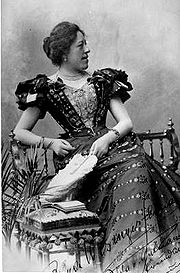
Olga Wisinger-Florian
Encyclopedia

Austria
Austria , officially the Republic of Austria , is a landlocked country of roughly 8.4 million people in Central Europe. It is bordered by the Czech Republic and Germany to the north, Slovakia and Hungary to the east, Slovenia and Italy to the south, and Switzerland and Liechtenstein to the...
n impressionist
Impressionism
Impressionism was a 19th-century art movement that originated with a group of Paris-based artists whose independent exhibitions brought them to prominence during the 1870s and 1880s...
painter, mainly of landscapes and flower still life
Still life
A still life is a work of art depicting mostly inanimate subject matter, typically commonplace objects which may be either natural or man-made...
s. She was a notable representative of Austrian Mood Impressionism.
Having trained as a concert pianist, Wisinger-Florian switched to painting in the mid-1870s. She was a student of Melchior Fritsch, August Schaeffer, and Emil Jakob Schindler. From 1881 she regularly showed paintings at the annual exhibitions mounted at the artist's house and later often showed at Vienna Secession
Vienna Secession
The Vienna Secession was formed in 1897 by a group of Austrian artists who had resigned from the Association of Austrian Artists, housed in the Vienna Künstlerhaus. This movement included painters, sculptors, and architects...
exhibitions. Work she showed at the Paris and Chicago international exhibitions earned her worldwide acclaim. The artist, who was also active in the middle-class women's movements of the time, was awarded numerous distinctions and prizes. Wisinger-Florian's early paintings can be assigned to what is known as Austrian Mood Impressionism. In her landscape paintings she adopted Schindler's sublime approach to nature. The motifs she employed, such as views of tree-lined avenues, gardens and fields, were strongly reminiscent of her teacher's work. After breaking with Schindler in 1884, however, the artist went her own way. Her conception of landscape became more realistic. Her late work is notable for a lurid palette, with discernible overtones of Expressionism
Expressionism
Expressionism was a modernist movement, initially in poetry and painting, originating in Germany at the beginning of the 20th century. Its typical trait is to present the world solely from a subjective perspective, distorting it radically for emotional effect in order to evoke moods or ideas...
. With landscape and flower pictures that were already Expressionist in palette by the 1890s, she was years ahead of her time.

